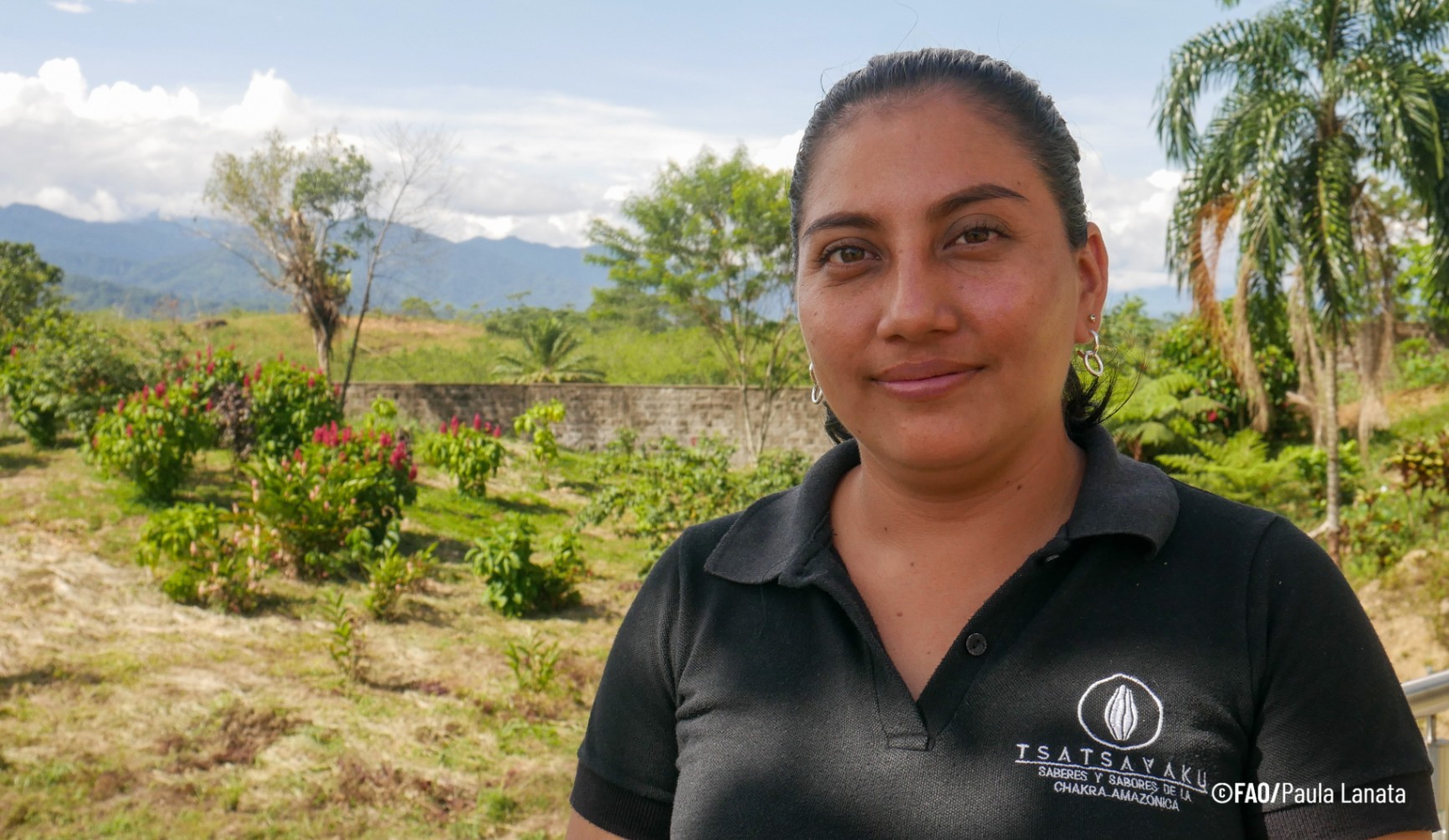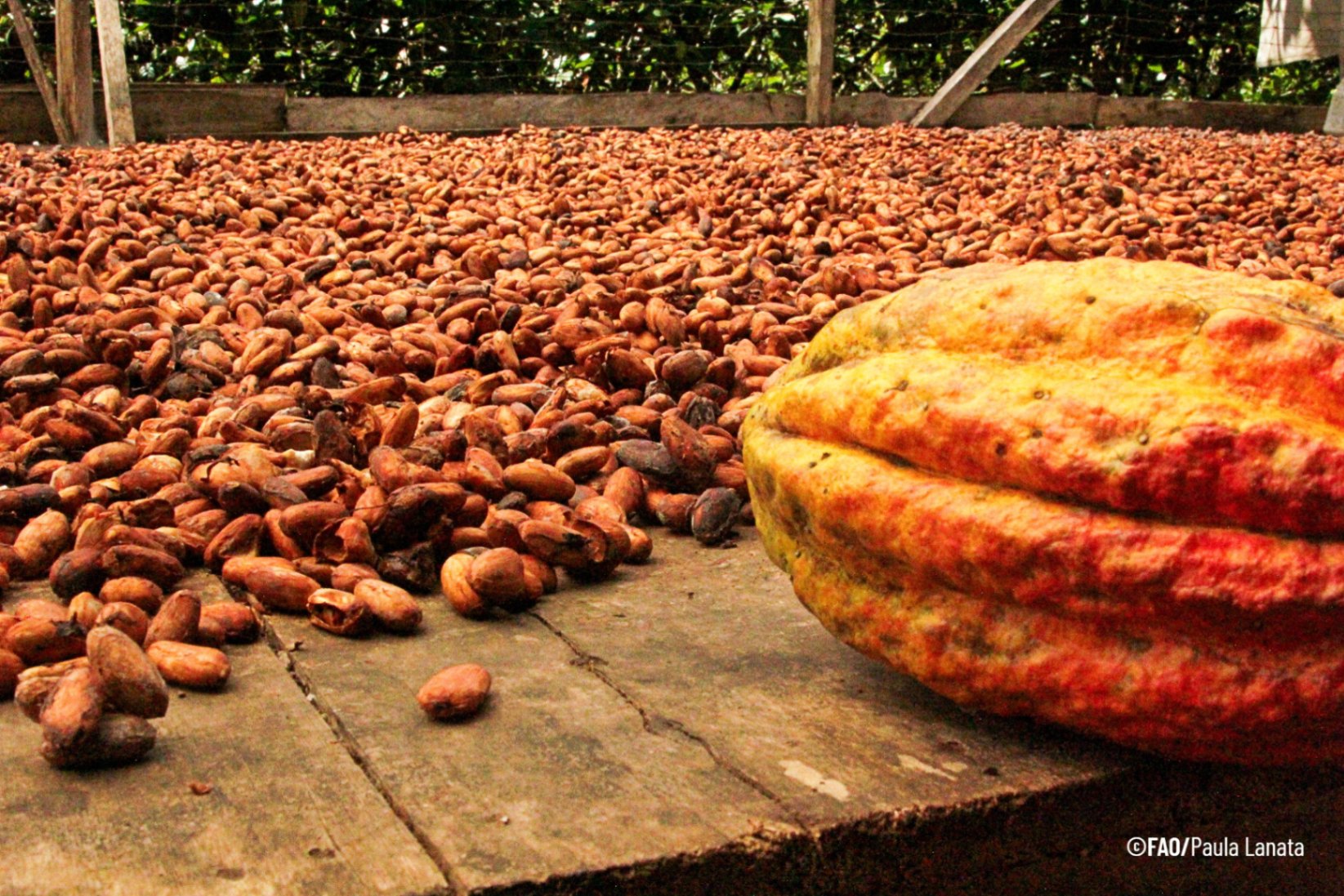.jpg?sfvrsn=8f4a7a38_5)
Women at the heart of agricultural heritage in Latin America
The women empowerment is the driving force behind the Globally Important Agricultural Heritage Systems (GIAHS) in Brazil, Ecuador, and Peru, recognized by the Food and Agriculture Organization of the United Nations (FAO)
From April to October, gatherers and their families climb the mountains to collect the main "everlasting flowers," staying there for weeks. This period also serves as a time for community gathering and social interaction.
FAO/Daniel Alves
06/03/2025
Andréia walks through a market in Brasilia where Semprevivas flowers and other handicrafts, collected and produced using an ancestral agricultural method, are sold by her community. Nelly coordinates a visit over the phone to Quito's airport to explore the possibility of showcasing the chocolate bars sustainably produced in her locality under the "Amazonian chakra" system. Luzmila, alongside her companions, carefully selects the last potato seeds from their gardens to take them to the seed bank in Puno, Peru, ensuring the biodiversity of this staple food.
The stories of these three women highlight the work and value they have developed in their communities, harnessing the potential of their environment while respecting and conserving natural resources. They are key figures in preserving traditional knowledge, which enables balance in the so-called Globally Important Agricultural Heritage Systems (GIAHS) in Brazil, Ecuador, and Peru.
For two decades, the Globally Important Agricultural Heritage Systems Programme has helped farming communities safeguard traditional agriculture, biodiversity, and cultural heritage.
By combining traditional knowledge with innovation, GIAHS contributes to ecosystem conservation, biodiversity, and climate change adaptation, while also strengthening farmers' livelihoods. Through the GIAHS Programme, the Food and Agriculture Organization of the United Nations (FAO) has designated 89 systems in 28 countries.
In Latin America and beyond, women are at the forefront of conserving biodiversity while contributing to their communities’ livelihoods and global food security.
As a vital force in their territories, women of different ages and communities are pillars of local development and contribute to building resilience against climate change challenges.


The Tsatsayaku Association, represented by Nelly Monar, was selected to be part of FAO’s Forest and Farm Facility, which supports small-scale forest and agricultural producer organizations in increasing their technical and business capacities.
Andréia Ferreira dos Santos: From flower gatherer to Quilombo heritage defender
Raised by her grandmother in the Quilombo Raíz community, Andréia has spent her entire life gathering the so-called Semprevivas flowers from Brazil’s Cerrado savanna, used to create long-lasting ornamental bouquets.
Harvested and dried, these flowers are essential for local communities in this vast tropical savanna region of eastern Brazil. In recognition of this cultural practice, FAO designated the system in 2020 as the first Globally Important Agricultural Heritage System (GIAHS) in Brazil.
Andréia belongs to the fifth generation of the Quilombo founded by her great-great-grandmother. Her identity is deeply rooted in the Serra do Espinhaço in Minas Gerais, where her community makes a living collecting these flowers. According to her, depending on the species and season, a person can gather up to one ton of flowers, selling them for between 25 and 70 reais (USD 5 to USD 12) per kilo.
However, with the arrival of eucalyptus plantations in the 2000s, monocultures gradually replaced forests and flowers. Seeking an alternative source of income, the community turned to handicraft development. “The cultural and economic impact was significant. One way to sustain our way of life was to add value,” Andréia explains. Since 2006, Quilombo Raíz's handcrafted golden grass products have been showcased at fairs across Brazil and even internationally.
That does not mean traditional activities were abandoned. “It remains important and is passed down through generations,” Andréia emphasizes, as it is an integral part of Quilombola culture and lifestyle. To advocate for her community’s rights, she joined social movements in 2014, becoming part of the Commission for the Defense of Extractivist Communities' Rights.
This mobilization helped the Serra do Espinhaço Traditional Agricultural System gain FAO certification, along with other Brazilian government recognitions, increasing the community’s visibility. These efforts successfully halted mining projects, preventing water contamination in gathering fields. “FAO’s recognition was crucial. The community understands that having water is far more valuable than money.”
With many achievements to date, the community continues to organize itself to secure its rights, thanks to the leadership of women. Female leadership, like Andréia’s, is dominant: “It’s a network of women working to keep the community thriving. The association is composed entirely of women. They are present in all contexts,” she proudly states.
Luzmila Mendoza: Guardian of native seeds and community leader for agrobiodiversity
Luzmila Mendoza is one of nine women from the Santa Rosa de Yanaque farming community in Ácora district, in the Puno region of Peru. At over 4,800 meters above sea level, they recover native seeds—an inheritance from their ancestors, grandmothers, and mothers—to preserve them for future generations.
“A seed is like my mother, like Pachamama,” says Luzmila, president of “Peruvian Producers for Agrobiodiversity” and the Yanaque Association. For her, caring for seeds is about more than survival; it is about empowerment and pride.
Native seeds are not only part of the cultural heritage of many Latin American communities but also reflect the fundamental role of rural women like Luzmila in preserving biodiversity and global food security.
Although products from these native seeds have little commercial value, Luzmila continues to cultivate them for her family’s consumption. “Native colored quinoa is more nutritious than white quinoa, but it sells for a lower price. That’s why we don’t grow it on a large scale—only for family consumption,” she explains.
Agricultural producers in Puno have recovered more than 50 varieties of native seeds. Luzmila alone has revived 26 potato varieties and various types of mashua, oca, olluco, cañihua, and native quinoa.
“I am proud to have recovered and to continue conserving these native seeds. I hope demand increases so that other women are encouraged to grow them, as they are strong and resistant to frost,” says Luzmila, highlighting the role that farmers play in adaptation and mitigation efforts against climate change.
When Luzmila Mendoza embarked on the task of recovering native seeds, the potatoes they produced were recognized by the elders in her village—varieties they had long believed lost. “My grandparents used Pintasqa potatoes, Pinta Milagros, and Misa Jiwra quinoa alongside Cantuta flowers to make offerings to Pachamama, which we still do today,” she explains.
Andean agriculture in Peru, which developed more than 5,000 years ago and has continuously adapted to the environment, was recognized by FAO as a GIAHS in 2011. These practices include terraces, ridge fields, local irrigation systems, tools, and endemic genetic resources such as potatoes and quinoa, cultivated across different altitudes.
In 2018, the producer association that Luzmila represents was contacted by the FAO-led project for Sustainable Agrobiodiversity Management and the Recovery of Vulnerable Ecosystems in the Andean Region of Peru, funded by the Global Environment Facility. Through the GIAHS approach, the initiative worked with them to conserve biodiversity on their farms, revalue traditional practices, and diversify their processes with technical assistance, integrating the efforts of family farmers, the central government, local governments, municipalities, agroecological producer groups, and the National Fund for Protected Natural Areas (Profonape).
Among the concrete initiatives implemented is the establishment of family and community seed banks in four Andean regions of southern Peru, including Puno. These have enabled many women to get involved and take on leadership roles in their communities.
.jpg?sfvrsn=375d234_5)
Andréia Ferreira dos Santos visits a sales point for "everlasting flowers" in Brasilia after attending a meeting of the Network of Traditional Peoples and Communities, which brought together Quilombo leaders.
Nelly Monar: Business manager with roots in Ecuador’s Amazonian Chakra
Nelly Monar grew up in a cattle-raising family in Tena, Napo province, in Ecuador’s Amazon region. She studied business administration but decided to dedicate herself to producing chocolate bars. Her determination, preparation, and commitment led her to become the legal representative of the Carlos Julio Arosemena Tola Fine Aroma Cocoa Producers Association, better known as the Tsatsayaku Association.
Her knowledge of chocolate production goes beyond business management. At Tsatsayaku, Nelly learned everything from managing cacao crops under the ancestral Amazonian chakra agroforestry system to working alongside technicians ensuring high-quality cacao beans and finished products like cacao paste, cocoa butter, nibs, chocolate bars, and artisanal bonbons.
The Tsatsayaku Association represents five groups of farmers producing cacao, wayusa, vanilla, plantains, sacha inchi, and other fresh products in Napo and Orellana provinces. The association promotes conservation of the ancestral "Amazonian chakra" system and sustainable use of natural resources. More than 2,400 families participate, over half of whom are women, with a quarter being youth.
Nelly believes that one of the biggest challenges in the organization is engaging more young people. Migration, illegal mining, and deforestation are everyday problems. However, she sees opportunities in rural areas and works to make her organization a space of possibilities for the many young Amazonians who long for such opportunities.
She has witnessed how Indigenous Peoples often face greater barriers, and at Tsatsayaku, they work with an intercultural approach. Nelly invests in her canton—the equivalent of a municipality in Ecuador—and believes that cooperation and communication between the government and international institutions must be strengthened.
The Amazonian chakra was recognized by FAO as a GIAHS in 2023 for being a unique model in which families sustainably manage productive spaces from an organic and biodiverse perspective, providing multiple services to local populations. Here, Kichwa and Kijus communities have developed a polyculture system that includes cacao alongside timber, fruit, medicinal, artisanal, edible, and ornamental species, as well as other activities such as hunting and forest product collection.
Women play a crucial role in the Amazonian chakra: they tend the plants and ensure their production. Receiving GIAHS recognition was a source of great pride, especially for them, as it allowed them to share the Kichwa worldview with the world and highlight the Indigenous culture of care that ensures the reproduction of life in the Amazonian chakras and forests.
The visibility provided by the GIAHS recognition has empowered producers by giving them greater control over the management of the Amazonian chakras and allowing them to add value to their ancestral cultivation practices. This has enabled them to secure better prices for their chocolate bars, reflecting the worth of their traditional farming techniques.
Nelly Monar is a woman who has challenged stereotypes and invested in her people. Her life story is one of love for her land and culture, and of the conviction that through collective work, education, and empowerment, it is possible to transform a community’s future and create new opportunities for the next generations.
